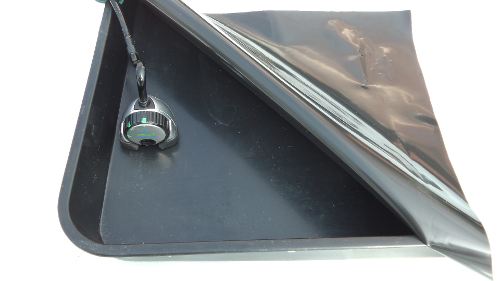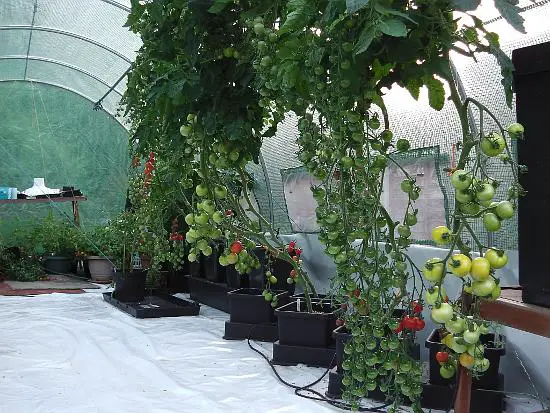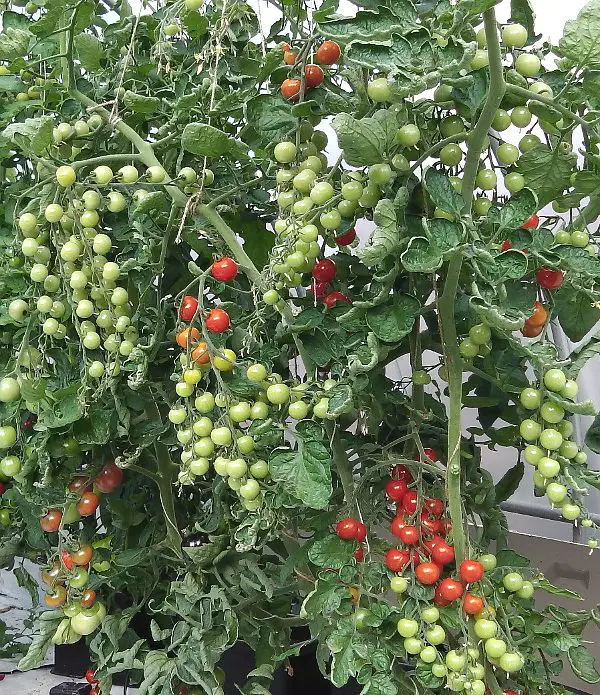Here’s part 2 of some of the most useful items for tomato growers.
The Fabric Pot
Last week we discussed the Air Pot, this week it’s the fabric pot, also known as the Dirt Pot, Smart Pot and Rhyzo Pot.

The benefit of this pot is that air can get into the root system. As we know, oxygen is essential for good root growth and for roots to stay healthy.
Fabric pots have advantages over Air Pots…
- They are less exensive than Air Pots
- The soil level is right at the bottom of the pot (unlike Air Pots) and can easily be sat in trays without using a wick.
- The fabric is surprisingly tough!
I use 11 litre pots.
When using trays, here’s a watering system that works very well.
Water Container + Aqua Valve or Smart Valve + Tray
This is one of my preferred methods because feed can be added to the water container. The valve creates a wet/dry cycle which is ideal.

Open trays are best made light-proof to avoid algae growth.

A variation on this method is a deep tray full of gravel or perlite which can also hold water.
A Roll Of Tape

It’s very easy to bend down to inspect your plants and not see the end of a cane – this is a quick way to make them more visable.
The Easy2grow AutoPot Kit
I’ve been growing tomatoes using the Autopot system for several seasons and I can say that this method is better than any other soil based system I’ve used – such as grow bags and grow pots. The only growing method that can come close, is the Quadgrow Planter.
If there is one thing that I’ve learned when using watering systems is that every one has its own peculiarities and needs to be tweeked before the best results can be obtained.

Getting Started
Setting up the AutoPot system is straightforward – just leave a little extra piping just in case you need to move the trays further apart. Work out the lengths needed by placing the trays and water tank in position first. That may seem obvious, but in the heat of the excitement of unpacking, it’s easy to cut the wrong lengths!
Root Control
Although the copper coated inserts are supposed to prevent roots escaping from the pot and blocking the valves, they aren’t 100% effective. It’s a good idea to inspect the valve compartment regularly – especially later in the season when plants and roots are well advanced. Roots can be trimmed if they stray near the aqua valve.
Surprisingly, even the small 8.5 litre pot is sufficient for a large cordon variety – see below!

Use Perlite In The Mix
Perlite in the mix and especially at the bottom of each pot is essential for best results.
The important thing is to use plenty of perlite or other similar medium especially at the bottom of each pot where there will be the most water saturation.
The wet/dry cycle of the valves combined with using a well aerated medium like perlite is a winning combination.
My experience has been mainly with perlite/potting compost mix, but vermiculite and coco fibre also work very well – on its own or as part of a mix.
The Aqua Valves
Aqua valves generally flood the trays more regularly than smart valves, and so a medium with plenty of aeration is essential. If there is more soil at a higher level in a pot that is OK, but the bottom couple of inches should be at least 50% perlite, otherwise saturated compost/soil will cause problems.
Encouraging Root Growth
Root development – Don’t use the valves until after the first five days or so.
In order to get the roots off to a flying start, one thorough watering is best followed by a period of “drying out” where roots are encouraged to grow in search of water.
Lots of little top-ups in the first few days of being planted will make the roots lazy and will have a negative effect on the vigour of the plant and fruit yield. After several days, the water supply and valves can be connected, and normal valve-watering started.
The Easy2Grow Autopot System is, in my view, one of the best systems available and I’ve had excellent results from it. The only downside is the cost but given that it should last many seasons, it is a good investment.
A Week Of Rain
It has rained every day this past week in my part of the UK – we even had hail stones yesterday! … the tomato plants growing outside have had enough!
You’ll notice that leaves start to become lighter and less healthy looking.
When leaves are covered in rain, they are unable to lose moisture (aka transpiration). If leaves cannot lose moisture, they cannot take up moisture and nutrients through their roots and so become nutrient deficient.
It is a “double wammy” because roots are unable to absorb nutrients in fully saturated,oxygen starved soil.
Tap roots are quite happy under water – we know this because we see it happening in the Quadgrow system when roots grow down into the reservoir. Roots close to the soil surface, do need access to plenty of oxygen which is a difficulty for outdoor plants when it rains every day!
I hope your plants are looking healthy!
Regards,
Nick

Robert Smith
Hi Nick, I’m maybe jumping the gun, I hope you don’t mind but i’m concerned that as my Black Cherry
plants are 3 ft. high now having been planted out on 1st. May they might be close to having exhausted
the compost in the Quadgrow pots, the first trusses (with flowers) are at 16 ins. from the rim of the pot 2nd. trusses are emerging some 12 ins. above the first. Would you advise starting to add the nutrients to the reservoirs or should I wait until the compost has reached its “6 weeks” feeding limit. Is it possible to overfeed the plants and if so does this cause harm.
Many thanks again for your very informative bulletins, much appreciated.
Nick
Hi Robert, It doesn’t cause any damage if you overfeed slightly, you’ll just get plants with more leaves than they should have and a delay with flower and/or fruit set. If you want to add nutrients to the reservoir after around four weeks from transplant, that’s OK.
Jess Allaway
Hi Nick,
I thought a while ago about trying out a few Dirt Pots but the thing I worried about was the fact that if they are air permeable does that not mean they dry out much more quickly than a solid pot? All my tomatoes are in the greenhouse so it can get pretty hot despite shading – a quick flood to the floor called for sometimes to bring temperature down quickly. Stability not a problem as my strings or canes are fixed to the overhead shelving. Might try a couple anyway, variety being the spice of life! Thanks for another great newsletter.
Nick
Hi Jess, they do dry out more quickly than standard pots but they are very good for sitting in large trays to make watering easy. It’s always good to compare them against the plastic Air Pots etc. and see which performs best.
Rhys Jaggar
Thanks for this, Nick, really helpful.
My experience of rhizopots is that 6 ft poles tend to be less stable in them than in more solid pots, so I tend to grow bush varieties (including the beefsteak Super Marmande) in Rhizopots and grow cordons in more solid pots. Rhizopots do give high quality fruit though.
My plants are mostly looking very good with first flowers on the March sowings and several fruit already set on the February Maskotkas.
We had 4 inches of rain here in 36 hrs, finally breaking the drought. Many seedlings in modules loved the dousing, as did climbing bean plants in pots. My Red Alerts outside are still surviving OK, with some small fruit growing away.
One final lesson I found this year was leaving finally potted up transplants away from the sun for 5 days – the odd one wilted in warm sun a day after transplantation, but is now fine after a week with quite a bit of cloud cover.
I treated myself to 50 six foot bamboo canes this spring – most are now doing sterling service, three to a plant. No wind disasters for me this year, I hope…..
Nick
Hi Rhys, I found the same with the rhizopots regarding stability – great for bush varieties or tall varieties if you use yoyos or fix a cane to a wall etc.
Sounds like you are off to a good start with plenty of flowers set already. A good supply of canes is very useful – I recently bought a new batch for my outside plants too.